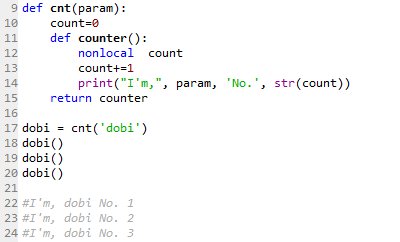什么是装饰器?
装饰器(Decorator)相对简单,咱们先介绍它:“装饰器的功能是将被装饰的函数当作参数传递给与装饰器对应的函数(名称相同的函数),并返回包装后的被装饰的函数”,听起来有点绕,没关系,直接看示意图,其中 a 为与装饰器 @a 对应的函数, b 为装饰器修饰的函数,装饰器@a的作用是:

简而言之:@a 就是将 b 传递给 a(),并返回新的 b = a(b)
栗子:

上面使用@dobi来表示装饰器,其等同于:qinfeng = dobi(qinfeng)
因此装饰器本质上就是个语法糖,其作用为简化代码,以提高代码可读性,运行上段代码的结果为:

解析过程是这样子的:
1.python 解释器发现@dobi,就去调用与其对应的函数( dobi 函数)
2.dobi 函数调用前要指定一个参数,传入的就是@dobi下面修饰的函数,也就是 qinfeng()
3.dobi() 函数执行,调用 qinfeng(),qinfeng() 打印“dobi”
什么是闭包?
首先还得从基本概念说起,什么是闭包呢?来看下维基上的解释:
在计算机科学中,闭包(Closure)是词法闭包(Lexical Closure)的简称,是引用了自由变量的函数。这个被引用的自由变量将和这个函数一同存在,即使已经离开了创造它的环境也不例外。所以,有另一种说法认为闭包是由函数和与其相关的引用环境组合而成的实体。闭包在运行时可以有多个实例,不同的引用环境和相同的函数组合可以产生不同的实例。
....
上面提到了两个关键的地方: 自由变量 和 函数, 这两个关键稍后再说。还是得在赘述下“闭包”的意思,望文知意,可以形象的把它理解为一个封闭的包裹,这个包裹就是一个函数,当然还有函数内部对应的逻辑,包裹里面的东西就是自由变量,自由变量可以在随着包裹到处游荡。当然还得有个前提,这个包裹是被创建出来的。
在通过Python的语言介绍一下,一个闭包就是你调用了一个函数A,这个函数A返回了一个函数B给你。这个返回的函数B就叫做闭包。你在调用函数A的时候传递的参数就是自由变量。
举个栗子:
def func(name):
def inner_func(age):
print 'name:', name, 'age:', age
return inner_func
bb = func('the5fire')
bb(26) # >>> name: the5fire age: 26
这里面调用func的时候就产生了一个闭包——inner_func,并且该闭包持有自由变量——name,因此这也意味着,当函数func的生命周期结束之后,name这个变量依然存在,因为它被闭包引用了,所以不会被回收。
另外再说一点,闭包并不是Python中特有的概念,所有把函数做为一等公民的语言均有闭包的概念。不过像Java这样以class为一等公民的语言中也可以使用闭包,只是它得用类或接口来实现。
nonlocal 语句
在 python 的函数内,可以直接引用外部变量,但不能改写外部变量,因此如果在闭包中直接改写父函数的变量,就会发生错误:

在 python 2 中可以在函数内使用 global 语句,但全局变量在任何语言中都不被提倡,因为它很难控制,python 3 中引入了 nonlocal 语句解决了这个问题:

Nonlocal 与 global 的区别在于 nonlocal 语句会去搜寻本地变量与全局变量之间的变量,其会优先寻找层级关系与闭包作用域最近的外部变量。
闭包与装饰器
上面已经简单演示了装饰器的功能,事实上,装饰器就是一种的闭包的应用,只不过其传递的是函数:

@makeitalic 装饰器将函数 hello 传递给函数 makeitalic,函数 makeitalic 执行完毕后返回被包装后的 hello 函数,而这个过程其实就是通过闭包实现的。@makebold 也是如此,只不过其传递的是 @makeitalic 装饰过的 hello 函数,因此最后的执行结果 在 外层,这个功能如果不用装饰器,其实就是显式的使用闭包:

闭包的作用
闭包的最大特点是可以将父函数的变量与内部函数绑定,并返回绑定变量后的函数(也即闭包),此时即便生成闭包的环境(父函数)已经释放,闭包仍然存在,这个过程很像类(父函数)生成实例(闭包),不同的是父函数只在调用时执行,执行完毕后其环境就会释放,而类则在文件执行时创建,一般程序执行完毕后作用域才释放,因此对一些需要重用的功能且不足以定义为类的行为,使用闭包会比使用类占用更少的资源,且更轻巧灵活,现举一例:假设我们仅仅想打印出各类动物的叫声,分别以类和闭包来实现:

可以看到输出结果是完全一样的,但显然类的实现相对繁琐,且这里只是想输出一下动物的叫声,定义一个 Animal 类未免小题大做,而且 voice 函数在执行完毕后,其作用域就已经释放,但 Animal 类及其实例 dog 的相应属性却一直贮存在内存中:

而这种占用对于实现该功能后,则是没有必要的。
除此之外,闭包还有很多其他功能,比如用于封装等,另外,闭包有效的减少了函数参数的数目,这对并行计算非常有价值,比如可以让每台电脑负责一个函数,然后串起来,实现流水化的作业等。
 What is Python Switch Statement?Apr 30, 2025 pm 02:08 PM
What is Python Switch Statement?Apr 30, 2025 pm 02:08 PMThe article discusses Python's new "match" statement introduced in version 3.10, which serves as an equivalent to switch statements in other languages. It enhances code readability and offers performance benefits over traditional if-elif-el
 What are Exception Groups in Python?Apr 30, 2025 pm 02:07 PM
What are Exception Groups in Python?Apr 30, 2025 pm 02:07 PMException Groups in Python 3.11 allow handling multiple exceptions simultaneously, improving error management in concurrent scenarios and complex operations.
 What are Function Annotations in Python?Apr 30, 2025 pm 02:06 PM
What are Function Annotations in Python?Apr 30, 2025 pm 02:06 PMFunction annotations in Python add metadata to functions for type checking, documentation, and IDE support. They enhance code readability, maintenance, and are crucial in API development, data science, and library creation.
 What are unit tests in Python?Apr 30, 2025 pm 02:05 PM
What are unit tests in Python?Apr 30, 2025 pm 02:05 PMThe article discusses unit tests in Python, their benefits, and how to write them effectively. It highlights tools like unittest and pytest for testing.
 What are Access Specifiers in Python?Apr 30, 2025 pm 02:03 PM
What are Access Specifiers in Python?Apr 30, 2025 pm 02:03 PMArticle discusses access specifiers in Python, which use naming conventions to indicate visibility of class members, rather than strict enforcement.
 What is __init__() in Python and how does self play a role in it?Apr 30, 2025 pm 02:02 PM
What is __init__() in Python and how does self play a role in it?Apr 30, 2025 pm 02:02 PMArticle discusses Python's \_\_init\_\_() method and self's role in initializing object attributes. Other class methods and inheritance's impact on \_\_init\_\_() are also covered.
 What is the difference between @classmethod, @staticmethod and instance methods in Python?Apr 30, 2025 pm 02:01 PM
What is the difference between @classmethod, @staticmethod and instance methods in Python?Apr 30, 2025 pm 02:01 PMThe article discusses the differences between @classmethod, @staticmethod, and instance methods in Python, detailing their properties, use cases, and benefits. It explains how to choose the right method type based on the required functionality and da
 How do you append elements to a Python array?Apr 30, 2025 am 12:19 AM
How do you append elements to a Python array?Apr 30, 2025 am 12:19 AMInPython,youappendelementstoalistusingtheappend()method.1)Useappend()forsingleelements:my_list.append(4).2)Useextend()or =formultipleelements:my_list.extend(another_list)ormy_list =[4,5,6].3)Useinsert()forspecificpositions:my_list.insert(1,5).Beaware


Hot AI Tools

Undresser.AI Undress
AI-powered app for creating realistic nude photos

AI Clothes Remover
Online AI tool for removing clothes from photos.

Undress AI Tool
Undress images for free

Clothoff.io
AI clothes remover

Video Face Swap
Swap faces in any video effortlessly with our completely free AI face swap tool!

Hot Article

Hot Tools

ZendStudio 13.5.1 Mac
Powerful PHP integrated development environment

mPDF
mPDF is a PHP library that can generate PDF files from UTF-8 encoded HTML. The original author, Ian Back, wrote mPDF to output PDF files "on the fly" from his website and handle different languages. It is slower than original scripts like HTML2FPDF and produces larger files when using Unicode fonts, but supports CSS styles etc. and has a lot of enhancements. Supports almost all languages, including RTL (Arabic and Hebrew) and CJK (Chinese, Japanese and Korean). Supports nested block-level elements (such as P, DIV),

SecLists
SecLists is the ultimate security tester's companion. It is a collection of various types of lists that are frequently used during security assessments, all in one place. SecLists helps make security testing more efficient and productive by conveniently providing all the lists a security tester might need. List types include usernames, passwords, URLs, fuzzing payloads, sensitive data patterns, web shells, and more. The tester can simply pull this repository onto a new test machine and he will have access to every type of list he needs.

SAP NetWeaver Server Adapter for Eclipse
Integrate Eclipse with SAP NetWeaver application server.

MinGW - Minimalist GNU for Windows
This project is in the process of being migrated to osdn.net/projects/mingw, you can continue to follow us there. MinGW: A native Windows port of the GNU Compiler Collection (GCC), freely distributable import libraries and header files for building native Windows applications; includes extensions to the MSVC runtime to support C99 functionality. All MinGW software can run on 64-bit Windows platforms.






